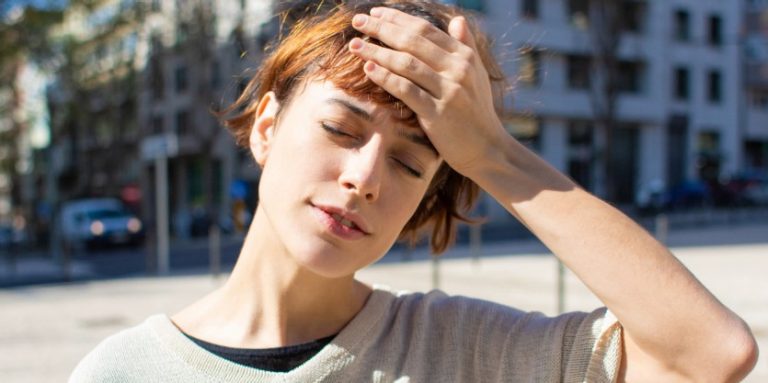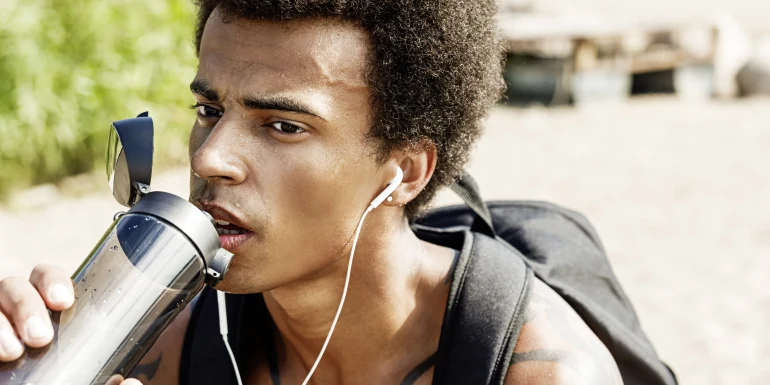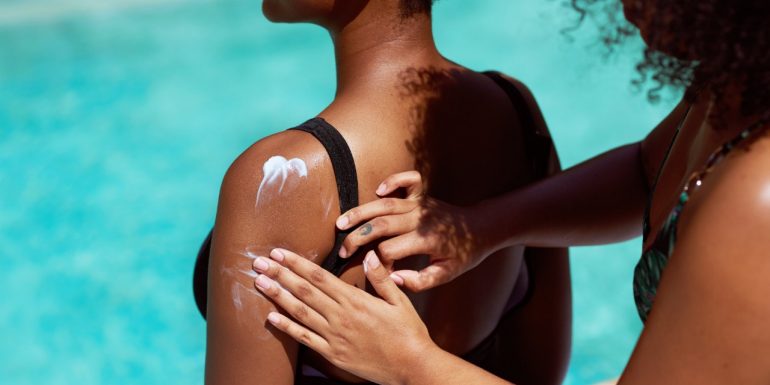
Sunstroke: heat accumulation in the head
On the first hot days of summer, the sun’s intensity is often underestimated – there is a risk of sunstroke. Find out here how to recognise, treat and, above all, prevent sunstroke.
After a summer’s day at the lake, you come home sun-kissed and happy. Suddenly, your head hurts, your neck is stiff and you suffer from nausea. That’s the insidious thing about sunstroke: the symptoms usually appear long after you have been in the sun.
What is the cause of sunstroke?
When the head, neck and throat are exposed to excessive and direct sunlight, heat builds up in the head. As a result, the brain swells and the meninges, which are located directly under the skull, become irritated.
In medical terminology, sunstroke is called insolation and is classified as heat exhaustion in emergency medicine.
What are the symptoms of sunstroke?
- Red, hot head
- Headache
- Neck pain, neck stiffness
- Nausea and vomiting
- Agitation
- Fatigue and weakness
- Occasional mild fever
- Dizziness
- Altered consciousness, confusion
- In case of severe symptoms, e.g. distinct neck stiffness, convulsions or increasing confusion, contact emergency services immediately.
What is the difference between sunstroke and meningitis?
Sunstroke has similar symptoms to bacterial or viral meningitis. In both cases, the meninges become inflamed. Bacterial meningitis, in particular, is a dangerous disease that can become life-threatening within a few hours. Unlike sunstroke, it is associated with high fever.
The risk of sunstroke is particularly high in infants and toddlers, because they have sparse hair, their skull bones are thin and they have a gap in their skulls (fontanelles). In addition, infants and toddlers sweat less and can’t adjust to temperature changes like adults can. Toddlers with sunstroke often refuse food or vomit it up. Frequently, they are pale, restless and whiny. In addition to the usual symptoms, children may also have a fever. Never leave children who have suffered sunstroke unattended and contact a doctor immediately.
First aid for sunstroke
- At the first symptoms, move the affected person immediately to a cool and shady place.
- Keep their head elevated to reduce pressure on the brain.
- Cool the head and neck: a wet towel is best for this purpose. The towel should be just lukewarm and not too cool.
- To compensate the loss of fluids through the burnt skin, the affected person should drink plenty of liquids. Here, too, the rule is: ensure drinks are not too cold to avoid overstraining the body.
- Until the symptoms subside, the person should avoid the blazing sun, drink plenty of fluids and give the body – especially the head – plenty of rest.
- Keep checking the affected person’s consciousness, breathing and vital signs.
- In urgent cases, call the emergency services.
What is the course of sunstroke?
Usually, the symptoms subside within hours to a maximum of two days. Adults often recover more quickly than children. If sunstroke is recognised in time and the correct measures are taken early, there is no lasting damage.
Whether you seek advice on diet and exercise, coping with a diagnosis or a recommended treatment, we will give you expert and individual answers. Our health consultation advisors will provide you with helpful information and practical tips.
Complications of sunstroke
If a person’s condition suddenly worsens, there may be a number of reasons:
When fluid enters brain cells, the brain swells. However, it cannot expand in the bony skull. Parts of the brain can be bruised and damaged. Symptoms often include impaired consciousness and bodily functions such as drowsiness, apathy, hallucinations, coma, seizures, speech problems, breathing problems and paralysis of the eye muscles. The course can be fatal. Call an ambulance or go to A&E immediately.
Affected persons may appear restless and agitated, but also apathetic and confused. Severe drowsiness, listlessness, sleepiness, confusion, hallucinations and fainting may be signs that the brain is no longer receiving sufficient blood supply. This may result in permanent damage. Make sure that the affected person lies with their legs elevated so that the blood can flow more easily to the brain. In case of unconsciousness, experts advise putting the person in the recovery position. If the situation does not return to normal, call the emergency services immediately.
Typical signs of shock are rapid heartbeat, very low blood pressure, pale skin, cool skin and cold sweat. Here, too, the blood supply to the brain is impaired and the circulatory system may collapse completely. Lay responsive persons flat and put their legs up. If unconscious, the recovery position is helpful. Do not leave the affected person alone and keep them awake. Check their pulse and breathing regularly. Call emergency services immediately.
How to avoid sunstroke
- Postpone sporting activities until the morning or evening.
- Stay in the shade if possible. Sunstroke most often occurs in people who fall asleep while sunbathing.
- Drink plenty of water or fruit juices diluted with water when it is hot. The recommended daily amount is two to three litres. Children require less fluid: 600 millilitres of fluid per day for one-year-olds, about one litre for ten-year-olds – the need for fluid increases in the heat.
- Always use sunscreen with an adequate sun protection factor.
- Cover your head and neck when walking or cycling: a cap, a scarf or summer straw hat work wonders. Children should always have their heads and necks covered, even in the water.
- Do not let children play in the blazing sun for too long.
- Light, loose clothing helps the body regulate its temperature.
- Avoid long car journeys in the sun.
- Never leave children alone in the car when it is very hot.
The name says it all: sunstroke is caused by sun exposure, heatstroke by heat – usually in combination with a lack of fluids. While sunstroke is limited to the head, heatstroke causes heat to build up throughout the body. The body overheats, temperature regulation fails and the affected person can no longer sweat. Signs of heatstroke are often cramps, hallucinations and disorientation. The pulse rate is high, blood pressure is low, the skin hot and dry. This condition is often mistaken for exhaustion or fatigue and heatstroke is therefore treated too late.
Move the affected person out of the heat immediately and call emergency services. The first aid measures are the same as for sunstroke.

The expert provided the editorial team with advice and input for this article. Julia Pieh (doctorate in pharmacy and toxicology, pharmacist, naturopath) works in the Helsana Health Consultation Service.


Newsletter
Find out more about current health issues every month and get all the information you need about our attractive offers from all Helsana Group companies * delivered by e-mail to read whenever it suits you. Our newsletter is free of charge and you can sign up here:
We did not receive your information. Please try again later.
* The Helsana Group comprises Helsana Insurance Company Ltd, Helsana Supplementary Insurances Ltd and Helsana Accidents Ltd.